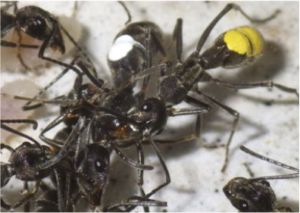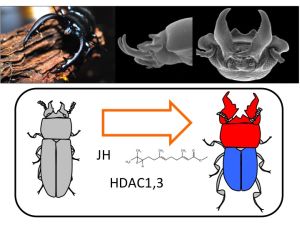|
|
 Animal Ecology Laboratory
Animal Ecology Laboratory
We focus on the ecology and evolution of sexually selected trait, social behavior, phenotypic plasticity, and life history of animals (mainly insects). Interdisciplinary approaches of behavioral ecology, development, and genetics are used to unveil the evolutionary mechanism of ecologically iconic traits.
|
|
Asc Prof |
Yasukazu Okada |
e-mail |
|
|
|
Ecological Developmental Biology of Phenotypic Plasticity
|
|

Dominance interactions of monomorphic ant Diacamma modify nutritional and reproductive physiology and gene expressions
Our research also steps into developmental, physiological and genetic mechanisms generating diverse social and sexual traits. Especially, phenotipic plasticity, the ability to generate diverse phenotypes from a single genotype, is of great interest. Castes in social insects and exaggerated horns and mandibles in beetles are fascinating examples of adaptive phenotypic plasticity. We apply multidisciplinary approaches such as gene expresion analysis (next generation sequencing, qRT-PCT), morphology, histology and physiology, to address the evolutionary mechanisms of ecologically unique traits.
|
|
|
Mechanisms generating social and sexual trait expression
|
|

Weapons of stagbeetle (Prosopocoilus) and broad-horned flour beetle (Gnatocerus)
Monomorphic ant Diacamma determines caste roles by unique dominance interaction (the mutilation of vestigial wings "gemmae"). The dominant females retain aggressiveness and initiate reproduction whereas subordinated females turns to be timid and they become reproductivelly arrested sterile helpers. Such dominance-driven reproductive differentiation are considered to reflect primitive form of caste differentiation and thus, this mechanism is fundamental in understanding the evolution of eusociality and altruism. So far, dominant females undergo up-regulation of insulin signaling in ovary and fat body (Okada et al. 2010; 2017), and dopaminergic signaling in brain (Okada et al. 2015). In addition to molecular techniques, we also apply automated behavioral tracking to accurately quantify behavioral variations and plasticity. Recent study uncovered that workers become active around-the-clock under the presence of immature broods (Fujioka et al. 2017).
As examples of sexual traits, we conduct studies on animal weapons. In broad-horned flour beetle Gnatocerus, males possess enlarged mandibles and they fight over females. By using next generation sequencing and RNAi-driven gene kockdowns, we are revealing the endocrinal and genetic basis of weapon exaggerations, such as juvenile hormone (JH, Okada et al. 2012) and histone deacetylases (HDACs, Ozawa et al. 2016).
|
|
|
Recent Publications
|
|
- Sasaki K, Okada Y, Shimoji H, Aonuma H, Miura T, Tsuji K. (2021) Social evolution with decoupling of multiple roles of biogenic amines into different phenotypes in Hymenoptera. Frontiers in Ecology and Evolution, 9, 287. https://doi.org/10.3389/fevo.2021.659160
- Okada, K., Katsuki, M., Sharma, M.D., Kiyose K, Seko T, Okada Y, Wilson A.J., Hosken D.J. (2021) Natural selection increases female fitness by reversing the exaggeration of a male sexually selected trait. Nature Communications 12, 3420. https://doi.org/10.1038/s41467-021-23804-7
- Kiyose K, Katsuki M, Suzaki Y, Okada K, Okada Y*(2021) Octopaminergic system orchestrates combat and mating behaviors: a potential regulator of alternative male mating tactics in an armed beetle. Journal of Insect Physiology 131, 104211.
- Journal of Insect Physiology (2021) 131, 104211.
- Okada Y, Katsuki M, Okamoto N, Fujioka H, Okada K. (2019) A specific type of insulin-like peptide regulates the conditional growth of a beetle weapon. PLOS Biology 17(11): e3000541.
- Fujioka, H., Abe, M. S. and Okada, Y. (2019) Ant activity-rest rhythms vary with age and interaction frequencies of workers. Behavioral Ecology and Sociobiology, 73: 30.
- Murakami, Y. and Hayashi, F. (2019) Molecular discrimination and phylogeographic patterns of clones across the Japanese Archipelago in the parthenogenetic gecko Lepidodactylus lugubris. Population Ecology, 61 (in press).
- Okamiya, H. and Kusano, T. (2019) Effects of landscape features on gene flow among urban frog populations. Ecological Research, 34 (in press).
- Ito, M. and Hayashi, F. (2019) Tree-leaf chemicals and feeding behavior of arboreal mammals in seasonal environment. In: Merillon, J. M. and Ramawat, K. (eds) Co-Evolution of Secondary Metabolites. Reference Series in Phytochemistry. 1-32 pp., Springer Nature, Switzerland.
- Horiuchi, K., Hashimoto, K. and Hayashi, F. (2018) Cantaridin world in air: Spatio-temporal distributions of flying canthariphilous insects in the forest interior. Entomological Science, 21: 306-314.
- Jingu, A. and Hayashi, F. (2018) Pitfall vs fence traps in feeding efficiency of antlion larvae. Journal of Ethology, 36: 265-275.
- Murakami, Y. and Hayashi, F. (2018) Behavioral interactions for food among two clones of parthenogenetic Lepidodactylus lugubris and sexually reproducing Hemidactylus frenatus geckos. Current Herpetology, 37: 124-132.
- Nakajima, R., Okamiya, H., Shimokawa, S., Yamamoto, K., Kato, H. and Murakami, N. (2018) Comparison of floral traits and pollinator assemblages of insular and mainland varieties of Lilium auratum. Plant Species Biology, 33: 276-288.
- Ohbayashi, K., Ishikawa, N., Hodoki, Y., Okada, Y., Nakano, S., Ito, M. and Shimada, M. (2019) Rapid development and characterization of EST-SSR markers for the honey locust seed beetle, Megabruchidius dorsalis (Coleoptera: Bruchidae), using de novo transcriptome analysis based on next-generation sequencing. Applied Entomology and Zoology, 54: 141-145.
- Okamiya, H. and Kusano, T. (2018) Lower genetic diversity and hatchability in amphibian populations isolated by urbanization. Population Ecology, 60: 347-360.
- Okamiya, H., Sugawara, H., Nagano, M. and Poyarkov, N. A. (2018) An integrative taxonomic analysis reveals a new species of lotic Hynobius salamander from Japan. PeerJ, 6: e5084.
- Tamura, N., Boonkhaw, P., Prayoon, U., Kanchanasaka, B. and Hayashi, F. (2018) Mating calls are a sensitive indicator of phylogenetic relationships in tropical tree squirrels (Callosciurus spp.). Mammalian Biology, 93: 198-206.
- Yang, F., Chang, W., Hayashi, F., Jiang, Y., Winterton, S. L., Yang, D. and Liu, X. (2018) Evolutionary history of the complex polymorphic dobsonfly genus Neoneuromus (Megaloptera: Corydalidae). Systematic Entomology, 43: 568-595.
- Yi, P., Yu, P., Liu, J., Xu, H. and Liu, X. (2018) A DNA barcode reference library of Neuroptera (Insecta, Neuropterida) from Beijing. ZooKeys, 807: 127-147.
- Phan, Q.T., Kompier, T., Karube, H. and Hayashi, F. (2018) A synopsis of the Euphaeidae (Odonata: Zygoptera) of Vietnam, with descriptions of two new species of Euphaea. Zootaxa 4375 (2): 151–190.
- Boonkhaw, P., Prayoon, U., Kanchanasaka, B., Hayashi, F. and Tamura, N. (2017) Colour polymorphism and genetic relationships among twelve subspecies of Callosciurus finlaysonii in Thailand. Mammalian Biology 85: 6-13.
- Fujioka H, Abe MS, Fuchikawa T, Tsuji K, Shimada M and Okada Y (2017) Ant circadian activity associated with brood care type. Biology Letters 13: 20160743.
- Ishikawa, N. F., Hayashi, F., Sasaki, Y., Chikaraishi, Y., Ohkouchi, N. (2017) Trophic discrimination factor of nitrogen isotopes within amino acids in the dobsonfly Protohermes grandis (Megaloptera: Corydalidae) larvae in a controlled feeding. Ecology and Evolution 3.2728.
- Ito, M., Tamura, N. and Hayashi, F. (2017) Seasonal changes in leaf chemistry and leaf selection of the Japanese giant flying squirrel upon two tree species. Ecology and Evolution 7: 5766-5773.
- Kishimoto, K. and Hayashi, F. (2017) The complete embryonic and larval stages of the oophagous frog Kurixalus eiffingeri (Rhacophoridae). Current Herpetology, 36: 37-45.
- Niitsu, S., Sugawara, H. and Hayashi, F. (2017) Evolution of female-specific wingless forms in bagworm moths. Evolution & Development 19: 9-16.
- Okamiya, H., Igawa, T., Nozawa, M., Sumida, M. and Kusano, T. (2017) Development and characterization of 23 microsatellite markers for the montane brown frog (Rana ornativentris). Current Herpetology 36: 63-68.
- Okada Y, Watanabe Y, Mandy MYT, Tsuji K and Mikheyev AS (2017) Social dominance alters nutrition-related gene expression immediately: transcriptomic evidence from a monomorphic queenless ant. Molecular Ecology 26: 2922-2938.
- Shimoji H, Aonuma H, Miura T, Tsuji K, Sasaki K and Okada Y (2017) Queen contact and among-worker interactions dually suppress worker brain dopamine as a potential regulator of reproduction in an ant. Behavioral Ecology and Sociobiology 71: 35.
- Hashimoto, K. and Hayashi, F. (2016) Cantharidin world on islands: Species diversity of canthariphilous arthropods in the Izu-Ogasawara Arc. Entomological Science 19: 432-439.
- Hashimoto, K., Sugawara, H. and Hayashi, F. (2016) Sclerotised spines in the female bursa associated with malefs spermatophore production in cantharidin-producing false blister beetles. Journal of Insect Physiology 93: 18-27.
- Hashimoto, K., Suzuki, K. and Hayashi, F. (2016) Unique set of copulatory organs in mantises: concealed female genital opening and extremely asymmetric male genitalia. Entomological Science 19: 383-390.
- Ito, M., Seto, N., Rico, B. Shigeta, M., Tamura, N. and Hayashi, F. (2016) Folivory with leaf folding by giant flying squirrels: its patterns and possible function. Ecological Research 31: 617-626.
- Ozawa T, Mizuhara T, Arata M, Shimada M, Niimi T, Okada K, Okada Y and Ohta K (2016) Histone deacetylases control module-specific phenotypic plasticity in beetle weapons. Proceedings of the National Academy of Sciences 113: 15042-15047.
- Sugawara, H., Kusano, T. and Hayashi, F. (2016) Fine-scale genetic differentiation in a salamander Hynobius tokyoensis living in fragmented urban habitats in and around Tokyo, Japan. Zoological Science 33: 476-484.
- Murakami, Y., Sugawara, H., Takahashi, H. and Hayashi, F. (2015) Different population genetic structure between sexual and asexual gecko species co-existing in the Ogasawara Islands. Ecological Research 30: 471-478.
- Yue, L., Liu, X., Hayashi, F., Wang, M. and Yang, D. (2015) Molecular systematics of the fishfly genus Anachauliodes Kimmins, 1954 (Megaloptera: Corydalidae: Chauliodinae). Zootaxa 3941 (1): 091-103.
- Liu, X., Hayashi, F., Lavine, L. C. and Yang, D. (2015) Is diversification in male reproductive traits driven by evolutionary trade-offs between weapons and nuptial gifts? Proceedings of the Royal Society of London B 282: 20150247
- Liu, X., Hayashi, F. and Yang, D. (2015) Phylogeny of the family Sialidae (Insecta: Megaloptera) inferred from morphological data, with implications on generic classification and historical biogeography. Cladistics 31: 18-49.
- Liu, X., Hayashi, F. and Yang, D. (2015) Taxonomic notes of the Neotropical alderfly genus Ilyobius Enderlein, 1910 (Megaloptera, Sialidae), with description of a new species. Deutsche Entomologische Zeitschrift 62: 55-63.
- Phan, Q. T., Sasamoto, A. and Hayashi, F. (2015) Description of two new species of the genus Devadatta from northern Vietnam and central Laos (Odonata: Devadattaidae). Zootaxa 3941 (3): 414-420.
- Sugawara, H., Nagano, M., Sueyoshi, T. and Hayashi, F. (2015) Local genetic differentiation and diversity of Oita Salamander (Hynobius dunni) in Kyushu revealed by mitochondrial and microsatellite DNA analyses. Current Herpetology 34: 1-11.
- Sugawara, H., Takahashi, H. and Hayashi, F. (2015) Microsatellite analysis of the population genetic structure of Anolis carolinensis introduced to the Ogasawara Islands. Zoological Science 32: 47-52.
- Tsuchiya, K. and Hayashi, F. (2014) Left-handed sperm removal by male Calopteryx damselflies (Odonata). SpringerPlus 3: 144.
- Hashimoto, K. and Hayashi, F. (2014) Cantharidin world in nature: a concealed arthropod assemblage with interactions via the terpenoid cantharidin. Entomological Science 17: 388-395.
- Liu, X., Price, B. W., Hayashi, F., De Moor, F. and Yang, D. (2014) Revision of the Megaloptera (Insecta: Neuropterida) from Madagascar. Zootaxa 3796 (2): 320-336.
- Chang, W., Hayashi, F., Liu, X. and Yang, D. (2013) Discovery of the female of Protohermes niger Yang & Yang (Megaloptera: Corydalidae): Sexual dimorphism in coloration of a dobsonfliy revealed by molecular evidence. Zootaxa 3745 (1): 84-92.
- Liu, X., Hayashi, F. and Yang, D. (2013) Taxonomic notes on the Protohermes changninganus species group (Megaloptera: Corydalidae), with description of two new species. Zootaxa 3722 (4): 569-580.
- Liu, X., Price, B., Hayashi, F. and De Moor, F. (2013) Systematic revision reveals underestimated diversity of the South African endemic fishfly genus Taeniochauliodes Esben-Petersen (Megaloptera: Corydalidae). Systematic Entomology 38: 543-560.
- Sekiné, K., Hayashi, F. and Tojo, K. (2013) Phylogeography of the East Asian polymitarcyid mayfly genus Ephoron (Ephemeroptera: Polymitarcyidae): a comparative analysis of molecular and ecological characteristics. Biological Journal of the Linnean Society 109: 181-202.
- Liu, X., Hayashi, F. and Yang, D. (2013) The Protohermes latus species group (Megaloptera: Corydalidae), with description of two new species from India and Myanmar. Zootaxa 3609 (5): 513–519.
- Liu, X., Hayashi, F. and Yang, D. (2013) The Protohermes dichrous species group (Megaloptera: Corydalidae), with description of two new species from eastern Malaysia. Zootaxa 3620 (4): 501-517.
- Hashimoto, K. and Hayashi, F. (2012) Structure and function of the large pronotal horn of the sand-living anthicid beetle Mecynotarsus tenuipes. Entomological Science 15: 274-279.
- Letardi, A., Hayashi, F. and Liu, X. (2012) Notes on some dobsonflies and fishflies (Megaloptera: Corydalidae) from northern Vietnam. Entomotaxonomia 34: 641-650.
- Liu, X., Hayashi, F., Viraktamath C. A. and Yang, D. (2012) Systematics and biogeography of the dobsonfly genus Nevromus Rambur (Megaloptera: Corydalidae: Corydalinae) from the Oriental realm. Systematic Entomology 37: 657-669.
- Liu, X., Hayashi, F. and Yang, D. (2012) A new species of alderfly (Megaloptera: Sialidae) from Yunnan, China. Entomological News 122: 265-269.
- Takechi, R. and Hayashi, F. (2012) Historical effects on local variation in walnut-feeding behavior by the Japanese wood mouse, Apodemus speciosus. Zoological Science, 29: 71-78.
- Takechi, R. and Hayashi, F. (2011) Transmission of walnut-feeding skills from mother to young in wood mice (Apodemus speciosus). Advances in Bioscience and Biotechnology, 2: 416-423.
- Liu, X., Price, B.W., Hayashi, F. and Yang, D. (2011) Revision of the fishfly genus Platychauliodes Esben-Petersen (Megaloptera: Corydalidae) endemic to South Africa. Zootaxa, 2909: 1-13.
- Liu, X., Hayashi, F. and Yang, D. (2011) Taxonomic notes and updated phylogeny of the fishfly genus Ctenochauliodes van der Weele (Megaloptera: Corydalidae). Zootaxa, 2981: 23-35.
- Kusano, T., Maruyama, K. and Kaneko, S. (2010) Body Size and age structure of a breeding population of the Japanese common toad, Bufo japonicus formosus (Amphibia: Bufonidae). Current Herpetology, 23-31.
- Tsuchiya, K. and Hayashi, F. (2010) Factors affecting sperm quality before and after mating ofcalopterygid damselflies. PLoS ONE 5: e9904.
- Hayashi, F., Shima, A., Horikoshi, K., Kawakami, K., Segawa R. D., Aotsuka, T. and Suzuki, T. (2009) Limited overwater dispersal and genetic differentiation of the snake-eyed skink (Cryptoblepharus nigropunctatus) in the oceanic Ogasawara Islands, Japan. Zoological Science 26: 543-549.
- Hayashi, F., Shima, A. and Suzuki, T. (2009) Origin and genetic diversity of the lizard populations, Anolis carolinensis, introduced to the Ogasawara Islands, Japan. Biogeography 11: 119-124.
- Liu, X., Hayashi, F. and Yang, D. (2009) Notes on the genus Protohermes van der Weele (Megaloptera: Corydalidae) from Vietnam, with description of two new species. Zootaxa 2146: 22-34.
- Liu, X., Hayashi, F. and Yang, D. (2009) Sialis navasi, a new alderfly species from China (Megaloptera: Sialidae). Zootaxa 2230: 64-68.
- Matsuno, S., Ohbayashi, N., Liu, X. and Hayashi, F. (2009) A list of Megaloptera (Neuropterida) specimens in the collection of the Ehime University Museum. Japanese Journal of Systematic Entomology 15: 457-468.
- Kusano, T. and Inoue, M. (2008) Long-term trends towards earlier breeding of Japanese amphibians. Journal of Herpetology, 42: 608-614.
- Liu. X., Hayashi, F. and Yang, D. (2008) Species of the Protohermes sabahensis group (Megaloptera: Corydalidae) from eastern Malaysia. Zootaxa. 1782: 49-60.
- Tsuchiya K. and Hayashi F. (2008) Surgical examination of male genital function of calopterygid damselflies (Odonata). Behavioral Ecology and Sociobiology 62: 1417-1425.
- Tamura N. and Hayashi F. (2008) Geographic variation in walnut seed size correlates with hoarding behaviour of two rodent species. Ecological Research 23: 607-614.
- Takechi R., Tamura N. and Hayashi F. (2008) Improved walnut-feeding skills with experiencee in wood mice, Apodemus speciosus. Journal of Ethology 27: 83-89.
- Hayashi F., Kamimura Y. and Nozaki T. (2008) Origin of the transition from aquatic to terrestrial habits in Nothopsyche caddisflies (Trichoptera: Limnephilidae) based on molecular phylogeny. Zoological Science 25: 255-260.
- Tamura, N. & Hayashi, F. (2007) Five-year study of the genetic structure and demography of two subpopulations of the Japanese squirrel (Sciurus lis) in a continuous forest and an isolated woodlot. Ecological Research 22: 261-267.
- Liu X., Hayashi F. and Yang D. (2007) Systematics of the Protohermes costalis species-group (Megaloptera: Corydalidae). Zootaxa 1439: 1-46.
- Kusahara, M., Kamimura, Y. & Hayashi, F. (2006) A new pair of primers for molecular sexing of the Pallas squirrel, Callosciurus erythraeus, and variation in fetal sex ratio. Mammal Study 31: 87-92.
- Kusano, T., Ueda, T. & Nakagawa, H. (2006) Body size and age structure of breeding populations of the Japanese salamander, Hynobius tokyoensis (Caudata: Hynobiidae). Current Herpetology 25: 71-78.
- Liu, X., Hayashi, F. & Yang, D. (2006) Systematics of the Protohermes xanthodes species-group in eastern Asia (Megaloptera: Corydalidae). Entomological Science 9: 399-409.
- Liu, X., Yang, D. & Hayashi, F. (2006) Discovery of Indosialis from China, with description of one new species (Megaloptera: Sialidae). Zootaxa 1300: 31-35.
|
|
|
 Animal Ecology Laboratory
Animal Ecology Laboratory
 Animal Ecology Laboratory
Animal Ecology Laboratory